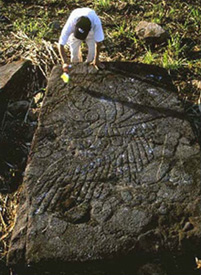
| FAMSI © 2001: Oswaldo Chinchilla |
||
Archaeological Research at Cotzumalhuapa, Guatemala
Research Year: 2000 Table of Contents
Introduction NOTE: The maps and plans that accompany this report are in an AutoCAD format, which requires the Autodesk® Express Viewer. With the software installed you will be able to pan across and zoom into selected areas of the maps by right clicking your mouse and using the features in the menu. Click on the button below for the latest version of Autodesk® Express Viewer from Autodesk.com. Recent research has substantially modified our understanding of the culture history, sociopolitical organization and ideology of ancient Cotzumalhuapa, one of the strongest and most innovative cultural and political centers of the Late Classic period in Southern Mesoamerica. Long known to scholars for its intriguing sculptural style (Gavarrete, 1929; Habel, 1878; Bastian, 1876; 1882; Eisen, 1888; E. Seler, 1892; Thompson, 1948; Parsons, 1967; 1969; Braun, 1976; Hatch, 1987), Cotzumalhuapa now emerges as a major urban center that encompassed the sites of Bilbao, El Baúl and El Castillo, together with settlements extending about 10 km2. Knowledge of the sculptural style and writing system has grown significantly, with documentation of numerous previously unknown monuments (Chinchilla, 1996a; 1998a). The long-term objectives of the Cotzumalhuapa Archaeological Project include (a) documentation of settlements in the Cotzumalhuapa Nuclear Zone, with emphasis on their spatial distribution, scale and integration; (b) detailed documentation of the Cotzumalhuapa sculptural corpus; (c) refinement of the local chronology and ceramic sequence with emphasis on the classic through colonial periods; (d) analysis of patterns of production and distribution of obsidian in the area; (e) documentation of peripheral centers, and refinement of current understanding of the distribution of settlements around the Cotzumalhuapa Nuclear Zone; (f) analysis of the regional role of Cotzumalhuapa within the general context of southern Guatemala and its broader relationship with other Mesoamerican societies. The 2000 field season witnessed significant advances. Major effort was devoted to long overdue laboratory analysis of materials recovered in previous field seasons. Field research included (a) intensive reconnaissance around the El Baúl site, to determine the extent and distribution of settlements in the northernmost part of the Cotzumalhuapa Nuclear Zone; (b) mapping and test excavations at the site of Palo Verde, a major peripheral center with Cotzumalhuapa-style sculpture; (c) test excavations at colonial period sites within the Cotzumalhuapa archaeological area; (d) continued recording of monumental sculptures. These activities ran parallel to a study of the Cotzumalhuapa causeway system, a network of stone-paved avenues that linked together the sites and settlements of the Nuclear Zone. This component was possible thanks to separate funding provided by the National Geographic Society (grant #6683-99). The causeway program demonstrated the existence of three major causeways, named after early pioneers in Cotzumalhuapa archaeology: (a) the Gavarrete causeway, about three kilometers long, that links together the sites of El Baúl and Bilbao; (b) the Habel causeway, possibly two kilometers long, that links the site of El Castillo with Golón, an important sector with monumental sculptures located one kilometer east of Bilbao; and (c) the Berendt causeway, about one kilometer long, which is an extension of the Gavarrete causeway, linking the sites of Bilbao and El Castillo. There are hints of the existence of other causeways. The existence of this formal system of communications among the major sites and settlement areas reinforces the interpretation of the Cotzumalhuapa Nuclear Zone as an articulated urban center. It also opens new questions in terms of the functional relationship between the major centers of monumental architecture and sculpture and their surrounding settlements. Click to download the report in PDF format: Archaeological Research at Cotzumalhuapa, Guatemala (1.14 MB) The PDF files require Adobe Acrobat Reader.
Submitted 03/01/2001 by: |
||
| Return to top of page | ||
|
Text links to all pages at this site are available at the FAMSI INDEX |
||

